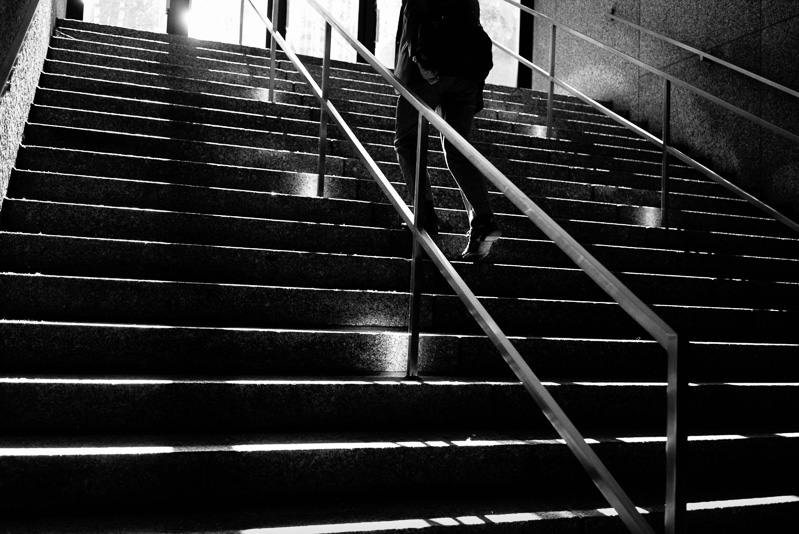Why do street photographers do so little work with white men in business suits? Why are they so preoccupied with “grittier” themes? After all, if street photographers ignore white men in business suits, those white men might feel left out. Who knows? They might even feel discriminated against.
If you take the time to talk to white men in business suits, you’ll discover that they are people too. I should know. Once or twice a year, I put on my armour and go out into the world as a white man in a business suit. It can be an alienating experience. It makes me feel lonely. I want people to hold my hand and to comfort me.

I took the photo above while wandering through Toronto’s financial district. During rush hour, a lovely late-afternoon light was streaming down a west-facing staircase. I positioned myself at the foot of the staircase and waited. Being a white middle-aged man means I blend right in. Okay, I have a mustache, but apart from that, I blend right in. Every now and then, a person would veer from the standard rush-hour course and climb the stairs. Click, click, click. And then I’d wait for someone else to pass.
This photograph (and my cheeky remarks at the opening of this post) point up a conflict inherent in street photography. There is a conflict between street photography’s professed claim to be a documentary discipline (maybe even a species of photojournalism) on the one hand, and its aesthetic aims as a photographic art on the other hand. Ethics and aesthetics.
As a documentary discipline, street photography aims to capture the world as it is. But it would be naive to believe that the world presents itself to us as it is; the world is mediated to us through our interpretive lens even before it passes through the camera’s lens. The world as it is includes white men in business suits, but street photographers make a decision to weight the world as it is in favour of less well-dressed subjects. At its best, this is the photographic expression of a liberation theology with its preferential option: photography becomes a radical approach that casts light into the dark corners of marginal lives.
This is high-minded language, and something worth aspiring to, but I don’t always trust photographers who use such language to justify their encounters with the world as it is. It’s telling that photography deploys the language of mastery to describe the mechanics of image-making. We capture moments in time. We frame the subject. We take photographs. The flavour of our language is distinctly colonial. Do photographers care about their disenfranchised subjects? Or do their actions merely fetishize the homeless and people of colour? Maybe this is just another species of poverty porn.
As an aesthetic discipline, street photography likewise aims to capture the world as it is. But “the world as it is” means something specific within the enterprise. Here, reality doesn’t refer to the world as it is so much as to a set of visual conventions that has evolved over the past 180 years. Elements in a photograph signal meanings just as words in novel. A catch-light in the eye signals a deeper interior life. Wrinkles on an elderly face signal wisdom and lived experience. An upturned gaze signals hope or optimism. In the same way, other elements can certify reality. The graininess of a high ISO, for example, suggests the grittiness of a dirty street. A slight blurring indicates motion, as if the photographer was pursued when the shutter was released. Perhaps the most important element to certify reality is the portrayal of suffering.
In his Poetics, Aristotle said that in order to produce the cathartic effect of tragedy, the poet had to evoke feelings of pity and terror. But in the age of Oprah and Disney, the rules have changed. Our world avoids tragedy the way bats avoid light. Our narrative insists on a redemptive end that’s won through suffering. Like the ancient poets, we are free to evoke pity with portrayals of suffering, but it’s an ironclad rule that we must simultaneously hint at the possibility of hope. If a narrative denies the possibility of hope, it denies everything we know to be real.
Suffering is the nexus where the twin aims of street photography come into conflict. As photojournalism, street photography justifies the portrayal of suffering as a way to expose the consequences of unfettered power and seeks to hold such power accountable. But as aesthetic expression, it forces the portrayal of suffering into the constraints of the prevailing narrative (perhaps invented by organs of that same unfettered power). That narrative trivializes suffering by attaching to it the puerile moral assumptions that are fed to us through social media and airhead news commentators: suffering is the prerequisite to redemption, and if redemption never comes, you probably didn’t deserve it anyways.
Returning to my photograph of the white man in a business suit, I think I understand what’s troublesome about it. While it includes a pseudo narrative of suffering and redemption (man climbs stairs and will eventually emerge into the light where he will go to his club and drink a single malt), it fails to fulfill the documentary convention because it offers us nothing to care about. It resorts, instead, to a faux grittiness. It trivializes the trivial. What could be more au courant than that?